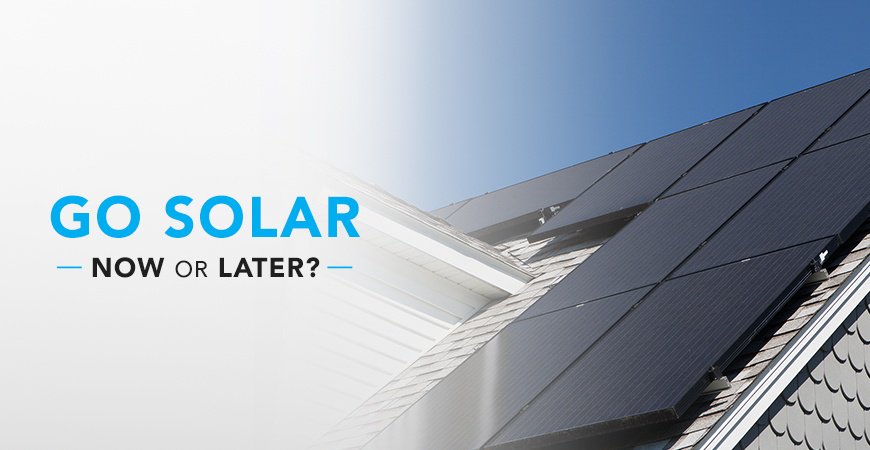
“Shouldn’t I wait to go solar until the costs are lower and the technology is better?” We get this question a lot at Solar.com – and it’s a great one. When we’re asked this at events, we usually respond, “the short answer is that it’s better to go solar now and take advantage of utility bill savings as soon as possible.”
Let’s take a moment to dive into the details of what we mean. Here’s the long answer…
Why You Should Go Solar Now
Assume a family owns an average-sized home in Southern California and uses a slightly above average amount of electricity for a bill of $300 each month. For them, they will probably be looking to install around 20 solar panels for a 5kW rooftop system, in order to completely offset their electricity usage with solar generation.
Given today’s residential solar market average of $3.00/watt, this will cost around $15,000 total and $10,500 after the 30% Federal Investment Tax Credit (ITC).
Waiting to Go Solar
Now, to determine the future price of home solar, let’s use the Department of Energy’s Sunshot Initiative goal of $1.60/watt in 2020. This very aggressive target would mean the same 5kW system would cost $5,600 after the federal solar tax credit.
That’s a $4,900 difference from the 2017 net price! But this family would also still be paying their utility bill as usual for the next 32 months. By deciding to go solar now, the monthly savings would be approximately $285 every month, after subtracting the utility bill that remains for costs like grid use charges.
For that 32 month period, the family would save $9,120 by going solar today — almost double the savings than if they chose to wait until 2020!
Combined with the additional benefit of immediately reducing your home’s reliance on fossil fuels, going solar now instead of waiting is the obvious choice.
Won’t Solar Panels Be More Efficient In The Future?
Another common question that is related to the cost of solar is panel efficiency. We often hear homeowners say that they would prefer to wait until solar panel efficiencies are higher and the technologies have proven themselves out for a longer period of time before they invest in their own system.
These perspectives make sense — the more efficient a panel is, the more energy will be produced and fewer panels will be needed, potentially saving on total system cost.
The reality is that solar technology has been around for decades. It was invented in the 1950s! While it has significantly improved efficiencies and durability since then, the technology has already matured to the point where leaps in efficiency or other breakthroughs are highly unlikely.
The highest efficiency panels on the market today are SunPower’s X-Series panels, which produce at around 21% average efficiency. This is a marked improvement from the 11% average efficiency rating of the early 2000s. However, if the industry is to keep pricing low by using conventional silicone materials, it will be practically impossible to attain better efficiency ratings because of the limitations of the material’s irradiance capacity.
The Decision on When to Go Solar Depends on Numerous Factors
All said and done, to get a true sense about the right time to go solar, your best bet is to speak with a specialist who understands the ins and outs of the industry.
As a neutral platform to receive quotes from qualified solar companies, Solar.com is your best resource to know when to move forward with your project, how much you will save, and what kind of panels are the best fit for your home.
Get started with our simple price estimator, or see how much you can save with solar, here with customized quotes!


 electric cooperatives. This is generally good news for Wisconsin homeowners, as a large majority of the population falls in investor-owned and municipal utility coverage areas.
electric cooperatives. This is generally good news for Wisconsin homeowners, as a large majority of the population falls in investor-owned and municipal utility coverage areas. 